Crystal Cabin Award victory for ViaSat
ViaSat’s Exede In The Air in-flight internet has proved itself in service – and has been recognized 16 months after launch in the Crystal Cabin Awards 2015 in the Passenger Comfort Systems category. Together with Thales, ViaSat launched the Exede In The Air service on December 12, 2013 on JetBlue.
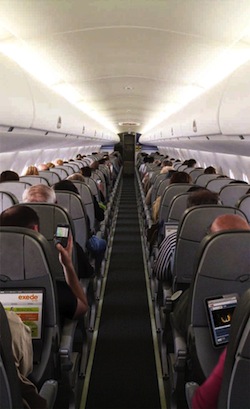 Since then, ViaSat says the service has achieved many milestones, including: attracting more than four-times the average number of passengers to the service on each flight compared to the nearest competitor (though the service is free to use), with take rates on flights of more than three hours approaching 40%; over 2.5 million personal electronic devices connected in the first year; data use per passenger doubling since the first flights; and 20% of all data consumed being used for streaming applications, a number the company says is increasing each month.
Since then, ViaSat says the service has achieved many milestones, including: attracting more than four-times the average number of passengers to the service on each flight compared to the nearest competitor (though the service is free to use), with take rates on flights of more than three hours approaching 40%; over 2.5 million personal electronic devices connected in the first year; data use per passenger doubling since the first flights; and 20% of all data consumed being used for streaming applications, a number the company says is increasing each month.
The reason for the success? The service provides similar speeds to those passengers enjoy at home (12Mbps per passenger), and this speed does not degrade when more passengers log on, and it also operates on the ground, enabling airlines to take advantage of gate-to-gate wi-fi connections.
The satellite-based system is also fitted to United aircraft, and is coming soon to El Al Airlines, with the first certification flights planned for mid-2015. The only downside is that the system is not currently available worldwide, but in mid-2016 the ViaSat-2 satellite is expected to launch, which will further expand capacity and extend service to Transatlantic, Central American, Caribbean, and European routes.
Thales reveals InFlyt Experience in plan to be top IFEC provider

The major news at Thales was a repositioning of the company’s IFEC activities, with the aim of being “the number one provider of IFEC solutions in the world,” as CEO of Thales’ IFEC activities, Dominique Giannoni, said in a press conference at the Expo.
A key step for Thales in achieving this ambition is the integration of its LiveTV activities into its IFEC business (LiveTV was acquired in March 2014 from JetBlue), to create a portfolio under the ‘InFlyt Experience’ banner that combines in-seat entertainment systems with wireless content streaming and high-performance connectivity services to give airlines options with which to design the IFEC experience they want to offer passengers.


A Thales spokesperson explained that the change was driven by a recognition of three key factors in today’s IFEC market: a growing global fleet and growing demand for IFEC systems on single-aisle aircraft as well as on shorter routes as the technology reaches maturity and costs go down; more technology-minded passengers requiring higher levels of technology interaction at all times; and intense competitive pressure for airlines to differentiate their brand and foster brand loyalty.
There are three fundamental elements of the Thales InFlyt Experience: Avant, FlytLive and FlytCare. Avant is an Android-based IFE system, which is currently flying with customers such as Qatar Airways (updates to the system were also announced – see below). FlytLive consists of broadband connectivity, connected services, and live content management services. Both of these are underpinned by FlytCare, a maintenance and repair service leveraged by Thales’s global support and service network.
According to Thales, a connectivity-enabled Android platform, when underpinned by strong application development services, can drive enhanced business-to-customer marketing, ancillary revenue generation, flight monitoring, data analytics and reporting to manage and utilize information and live content.
As Giannoni mentioned in the press conference: “Airlines no longer accept IFE to be a static cost center; they want a positive branding and marketing tool to drive customer retention and direct monetization.”
Giannoni added, “We believe Thales InFlyt Experience is going to revolutionize passenger air travel and the way airlines see IFE providers… with the integration of LiveTV’s activities completing our offer, we are ready to reach new heights for the benefit of our airline customers.”
Live TV benefits
The integration of its LiveTV activities also means that Thales can offer an IPTV service for a near real-time feed of live TV programs. By using real-time satellite feeds, popular television events, such as sports matches, can be streamed to aircraft equipped with IPTV services from a dedicated Thales lab that is tasked with controlling, transcoding, and disseminating the TV signal via the Thales connectivity system.
According to the company, its service is unique as, instead of simply drawing content directly from TV networks with no control over what is broadcast, the Thales system will broadcast only the valuable events from various content providers to the aircraft and record the programs for on-demand playback. This approach eliminates irrelevant programming and makes the most efficient use of aircraft bandwidth, as well as allowing airlines to stream relevant content that effectively targets their customers.
New in-seat hardware
Thales also revealed updates to its Avant hardware. The first was a range of new, larger displays, with 10-22in HD monitors for economy and 24in and 32in Ultra HD monitors for premium cabins. As well as passenger benefits, Thales claims these displays offer a 35% reduction in weight and a 20% reduction in power per screen compared with their predecessors. Equipped with the latest generation quad-core processors and USB 3.0 for PED charging, the displays will also be faster and will be able to have a local storage capacity of more than 512GB.
The next generation of Thales’ Android-based Touch Passenger Media Unit (TouchPMU) hand-held IFE controller was also revealed, featuring a 5in multi-touchscreen (70% larger than its predecessor), as well as haptic feedback technology. Another new feature, a ‘point-in-air’ motion sensor, lets the user navigate the content by pointing the TouchPMU at the screen, which allows them to navigate content through the TouchPMU while keeping the second screen experience.
Double celebration at Panasonic Avionics
Panasonic Avionics (Panasonic) announced its acquisition of Tactel, a Swedish mobile app and software consultancy, as part of an ongoing strategy to enhance its capabilities in software and design.
Tactel will augment Panasonic’s existing engineering and software expertise in the consulting and development of apps, portals, visual and interactive design and back-end services. The consultancy will operate as an independent unit of Panasonic Avionics and will continue to work with its customers in the media, mobile and financial services industries.
Paul Margis, president and CEO of Panasonic Avionics said, “Tactel is a unique and innovative company that delivers custom solutions with the personalized, rich experiences that today’s connected passengers demand. We believe Tactel’s unique blend of solutions and services will help enhance our in-flight entertainment and broadband connectivity offerings.”
Panasonic was also celebrating the 700th aircraft installation of its eXConnect Ku-band in-flight wi-fi system. After solving bird strike issues, Panasonic installed the system on 250 aircraft in 2014, and over 300 are planned for installation this year to achieve the 1,000th aircraft in Q1, 2016. In total, 56 airlines have committed over 2,200 aircraft to the eXConnect system.
The company is also intending to introduce massive capacity increases later this year, including 200Mbps over CONUS (Continental US), the Atlantic Ocean and into Europe, with HTS (high throughput satellite) providing increased bandwidth. With future updates planned over Europe and Asia, HTS will cover all of the world’s high traffic areas by Q4 2017.
Margis said of the rise in demand for connectivity, “We believe every aircraft should be connected, regardless of its mission. What was once viewed as a passenger amenity has quickly become a business imperative for our customers. The connectivity discussion with our customers has moved beyond the size of the pipe; what matters most for our customers is how they can use connectivity to improve their business.”
Lufthansa Technik develops tablet IFE concept, created for Qantas
Lufthansa Technik was showing the fruits of a 10-month project with Qantas to develop and implement a concept that uses a tablet to replace the traditional seatback screen. The project was driven by a desire to work around the current requirement for Qantas’ passengers to hold their hand-held IFE devices during taxi, take-off and landing to comply with aviation regulations.
The system – designed with Lufthansa Technik’s Original Equipment Innovation division – allows for a tablet to be fitted to the back of a seat inside a secure holder that allows the device to be used for all stages of flight, giving it similar functionality to a seatback touchscreen display. Any tablet can be used, though the iPad is the least suitable as its battery cannot be detached making certification more difficult, Norbert Müller, SVP of BoardConnect at Lufthansa Systems told Aircraft Interiors International at the Expo.
The system on show at the Expo – and which was also a runner-up in the Crystal Cabin Awards [LINK] – used a Samsung tablet integrated with an aircraft seat from ZIM Flugsitz, and the design had passed HIC tests: indeed the seat and system will be installed in the business cabin of Qantas\\\’s Boeing 717 aircraft, and access to IFE content will be available at all stages of the journey.
“In view of the fact that innovation cycles in IFE are growing ever shorter, our solution offers airlines enormous benefits. It is less expensive and easier to maintain than a built-in seat back monitor, and at the same time, airlines can always offer their passengers state-of-the-art technology in their IFE systems,” stated Franziska Voerner, project manager at Lufthansa Technik.
Gogo keeps crews connected
Gogo launched Crew Connect for Airline Operational Services, a dynamic messaging platform that allows flight crews to communicate with each other via voice or text messaging, and with ground crews while the aircraft is in flight. The service is application-based, available on Android, Apple and Microsoft devices that offer group messaging, event-based alerts, multi-media messaging and message tracking.
Ash ElDifrawi, Gogo’s chief commercial officer, explained, “Today, numerous airlines are issuing their flight attendants and pilots with wi-fi enabled tablets and smartphones that are capable of utilizing aircraft connectivity; Crew Connect leverages that trend.
“The only other way for cabin crew to communicate off the aircraft is through traditional flight deck voice or datalink (ACARS) systems, which have historically been difficult and expensive to utilize for in-flight cabin crew communication. This service will give airlines an inexpensive way to keep crew connected and informed while in the air, with the ultimate goal of helping airlines improve efficiency.”
The technology is based on IP messaging platform technology, with features including: dynamic call grouping, which allows an airline to send communications to an entire aircraft, fleet or region; status notifications such as ‘message read’ and ‘on aircraft’; and hot button calling to airline-designated sites such as dispatch, scheduling and maintenance.
“Although optimized for Gogo’s network, Crew Connect is also available to airlines with alternative connectivity suppliers,” indicated Andrew Kemmetmueller, Gogo’s VP – airline operational services and platforms.
“The service is designed to maximize the communications value of any broadband link for the airline, bringing improved functions on any connected aircraft.”
The Integrated Flight Experience
digEcor was showing not just the technology one might associate with IFE, but also demonstrating a wider product range that can create a low-cost ‘Integrated Flight Experience’, bringing together entertainment, power, lighting and crew and passenger connectivity. The modular product range can either be retrofitted or installed as a post-delivery modification of new aircraft.
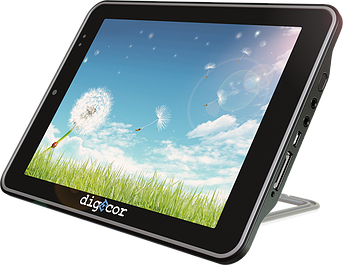 One of the new parts of the range is the fifth-generation digEplayer NV, a portable HD audio video on-demand (AVOD) solution designed to offer airlines the practical features of a custom device, while passengers enjoy the contemporary look and feel of a consumer tablet, all at a low total cost of ownership.
One of the new parts of the range is the fifth-generation digEplayer NV, a portable HD audio video on-demand (AVOD) solution designed to offer airlines the practical features of a custom device, while passengers enjoy the contemporary look and feel of a consumer tablet, all at a low total cost of ownership.
The digEplayer NV is available in 8, 10 and 12in versions, and according to the company, it is approved for early window content from all major studios and independent distributors. The devices can be specified with either a Linux or Android operating system, which supports motion/gesture games and allows for easy integration of applications and new media including fully customizable GUIs to generate ancillary revenues and branding opportunities.
Other features of the digEplayer NV include an integrated stand mounted directly to a metal chassis, reinforced dual headphone jacks, up to 1TB of SSD storage, USB power, gigabyte Ethernet content loading, switchable batteries (12 or 18 hour), ‘smart status’ battery charging, and Bluetooth and wi-fi support. Content is updated via a content update rack using Gigabit Ethernet or by swapping optional SD cards.
According to digEcor CEO David Withers, the company has studied the failure modes and airline hurt points of its portable media players already in service and designed them out of the NV series.
Next-gen Glide details revealed
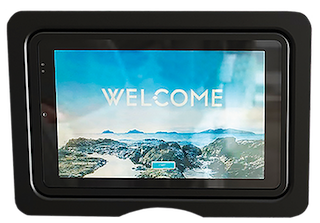 digEcor also revealed details of its research and development of future technologies, including its next-generation Glide embedded IFE system. The original system was developed as a way to overcome the inherent issues in legacy systems, and to remove concerns about head-end server reliability and redundancy and the storage and distribution of files.
digEcor also revealed details of its research and development of future technologies, including its next-generation Glide embedded IFE system. The original system was developed as a way to overcome the inherent issues in legacy systems, and to remove concerns about head-end server reliability and redundancy and the storage and distribution of files.
The next-generation system still keeps that ethos as its basis, but according to digEcor, it does so with reduced costs and increased on board content storage.
“The seat box we are currently installing has the capability of moving the storage of files from the screen into what we call the cabin network layer,” explained CEO David Withers.
“By using modern cluster technologies, we can tie together the processing and storage capabilities of the many seat boxes in a typical IFE installation to form a large and redundant cabin ‘supercomputer’. There is no longer a need to replicate each and every audio and video file in every seat, nor to rely on single copies of content stored on head-end servers susceptible to many single points of failure.”
According to the company, this design allows storage capacities in the tens of terabytes, enabling the carriage of huge content sets at a lower cost than current systems offer.
“Initial testing also suggests that the faster processing power may enable individual watermarking of wi-fi streams to achieve early window wi-fi to PED certification. The seat boxes already contain a low power wi-fi access point,” added Withers.
Responding to the trend of airlines moving away from overhead display systems to seatback digital systems in order to enhance the passenger experience and enable greater ancillary revenue opportunities, digEcor says that the Glide displays – available in 8in or 10in versions – are well-suited to narrow-body aircraft seats and are priced lower than overhead systems. Larger sizes are available for premium cabins, as are USB 2.1 Amp and 110V power options.
A350 flying with Cobham antenna
Cobham Satcom, a manufacturer of Inmarsat satellite communications systems, was proudly announcing that its HGA-7001 High Gain Antenna is now part of the connectivity solution for the Airbus A350-900. The low-profile antenna, plus the company’s DAU-7060 DLNA (diplexer/low-noise amplifier) and floating mounting plate, are standard fit on the A350 XWB through a sub-contract with A350 XWB communications systems provider Rockwell Collins.
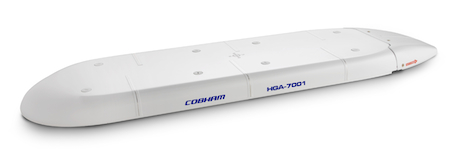
Cobham has delivered more than 50 antennas to date for the A350 XWB, with the HGA-7001 claimed to lead its field in terms of drag reduction, low weight, compactness, low angle coverage and power requirements for aircraft connectivity systems. For the A350 XWB, a special mounting plate was designed to ensure that the antenna does not impart stresses on the composite airframe structure.
The HGA-7001 features phased-array technology and can be used with Inmarsat Classic Aero (H/H+), Swift64 and SwiftBroadband Satcom systems for multi-channel service for a range of applications. Meanwhile the DAU-7060 DLNA separates transmit and receive signals, and amplifies the received signal to ensure that specified signals in the transmit band from the HPA are transmitted to the antenna with minimal power leaks into the receive band Low Noise Amplifier (LNA). It also filters unwanted harmonics generated in the HPA, providing protection against interference with other systems. The system is ARINC-741 compliant and is compatible with Aero H/H+, Swift64 and SwiftBroadband systems.
GX brings the connected aircraft closer
The fully connected aircraft was the theme at SITA OnAir, an Inmarsat distribution partner for the GX Aviation global Ka-band network. At the show, SITA OnAir and Inmarsat showed a GX Aviation demo operating over a live GX link, so visitors could see what passengers, the cabin crew and pilots will experience using the 50MB/s system.
If you missed it, click HERE to play the SITA OnAir GX Aviation demo video
“Passengers now expect to be able to stay in touch when they are flying. Social media, email, text messaging and calls are the norm,” said Ian Dawkins, CEO of SITA OnAir.
“What’s new is that super-fast broadband for in-flight connectivity now extends to new satellite networks for both passenger and airline use. Airlines will be able to exchange data for operational purposes, and passengers will have the same internet speed they are used to at home.”
The successful first test was carried out in March in the Inmarsat lab at the company’s London headquarters. The company says the GX Aviation satellite network was tested rigorously, using passenger, crew and aircraft applications. This included replicating usage onboard a commercial aircraft, which demonstrated that GX Aviation has the bandwidth to meet and exceed all expectations, according to SITA OnAir.
Dawkins continued, “We are providing our current customers with a clear and straightforward upgrade path to GX Aviation, including all the necessary installation capabilities across the world. In fact, we have already initiated work on the STC project for the Boeing 777 to operate our products and services over the GX Aviation network”.
Airline Services Interiors secures BA B747 IFE upgrade contract
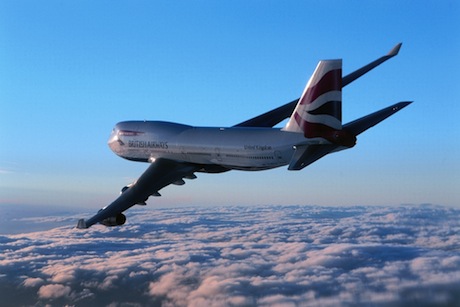 Airline Services announced at the Expo a new corporate structure, with three divisions, one of which is a dedicated interiors business, named Airline Services Interiors. This division is off to a great start, having been awarded a contract to integrate a lighter and better IFE system into every class on 18 Boeing 747s operated by British Airways (could this be a change of direction from this announcement in September 2014? We will find out and report back).
Airline Services announced at the Expo a new corporate structure, with three divisions, one of which is a dedicated interiors business, named Airline Services Interiors. This division is off to a great start, having been awarded a contract to integrate a lighter and better IFE system into every class on 18 Boeing 747s operated by British Airways (could this be a change of direction from this announcement in September 2014? We will find out and report back).
Airline Services Interiors is responsible for the design, certification and manufacture of the modification kits, which will be integrated into the new IFE system. The division is working with Panasonic Avionics and aircraft integrator Zodiac NAT to fit eX3 IFE systems into the aircraft, beginning in September 2015.
As part of the upgrade, Airline Services Interiors has also integrated new universal power sockets at every seat in World Traveller Plus (premium economy), together with individual USB sockets to allow customers to power their phones and tablets.
The cabin interiors of the 18 B747s are also being refreshed so they match those on the airline’s new A380 and B787 aircraft, and Airline Services Interiors has developed new fitted seat covers to improve comfort and appearance.
Trial integration and first article seat build is being carried out at Airline Services Interiors’ Passenger Seating Centre of Excellence, which is co-located with the design and manufacturing teams in Manchester, UK. Certification of the three seat types is complete, with first article inspection of the seat modification design phase nearing completion. Airline Services Interiors will support the seat modification program by British Airways Interiors Engineering at its facility in Blackwood, Wales, UK, where the first aircraft is due to be refurbished by British Airways in Summer 2015.
Triple launch at IFPL
There were no fewer than three product launches at Inflight Peripherals’ (IFPL) stand, the first being dual breakaway and triple breakaway jacks, claiming to offer a cost-neutral way to deliver magnetics jack technology to help eliminate the problem of broken headset jacks – and the uncomfortable passenger experience of standing up while headphones are still plugged in.
Research by IFPL found that up to 10% of headsets coming off long-haul flights are not re-usable due to damage, which often results in broken pins left in the sockets, rendering the IFE experience useless. The company says that its magnetic jacks can be installed at the same cost as conventional jacks, and that headsets suitably equipped also cost no more than their pin-jack counterparts. The jacks are backward-compatible with all existing headset connector types and incorporate the company’s long-life jack, which has been tested to over 100,000 insertions.
The second reveal was the latest near field communication (NFC) technology, which IFPL says could be in service during 2015. David Thomas, head of business development at IFPL, explained, “One big aspect driving NFC solutions is that later in 2015 the liability for fraudulent transactions will move away from the issuer of the card and onto the merchant of record for card present transactions. NFC not only enables airlines to enhance on-board revenue and personalize the passenger experience, but also provides a more secure payment technology for low-value transactions and purchases.”

The final launch was a reversible USB power and data module (pictured left) for providing at-seat PED power for charging and data transfer without requiring modification or recertification of existing seats. The module can be easily incorporated into line-fit aircraft or as a retrofit, and the full data transfer capability allows system-wide IFE integration for improved passenger personalization.
Another innovative feature is the customizable light guide within each unit whereby the color can be adjusted to support not only night flights, but also to support an airline’s brand identity. The module has been tested to over 60,000 insertions, and its reversible insertion capability minimizes customer induced damage.
High-speed Ka-band wireless antenna

Honeywell Aerospace, Inmarsat and Kymeta (a company that develops flat-panel antennas for satellite communications) announced they are working together to design, create and test a new, higher-speed Ka-Band wireless antenna for business and commercial aircraft customers. The partners say that the new antenna will have “unique and advanced capabilities” that will bring faster connectivity and a higher quality broadband service to aircraft.
The smaller and more compact design of the antenna allows it to be installed on a wider variety of aircraft, including smaller business aviation aircraft. The flat-panel design is lightweight for reduced weight and drag, in turn reducing fuel and maintenance costs.
All three companies will work together to bring this antenna to the market. Kymeta will deliver its mTenna antenna products to Honeywell, which will be responsible for testing and integrating the antenna into its JetWave aviation product line. JetWave is the family of satellite communications hardware that exclusively supports Inmarsat’s GX Aviation service.
Vistara selects IntelliCabin IFE

Indian carrier Vistara – a joint venture between Tata Sons and Singapore Airlines which launched in January – has selected BAE Systems’ IntelliCabin IFE system, which provides inflight wireless streaming of preloaded content to PEDs across all three cabin classes in its fleet of A320s (six at present, with orders for a further 14). The system includes fully integrated Samsung Galaxy Tab S tablets for business class customers, while premium economy and economy passengers use their own devices.
The system is expected to go live in October 2015, but in the interim, BAE Systems is providing Vistara’s business class customers with customized Samsung Galaxy tablets with specially selected preloaded content including movies, TV shows, magazines and games. This interim solution is available on flights of more than two hours’ duration.
“We are extremely happy to be launching the pioneering technology of inflight wireless streaming in India. The first of its kind IFE solution is the outcome of much deliberation and we sought to ensure that it was innovative, ground-breaking and novel for our customers,” said Prasad Menon, chairman, Vistara. “BAE Systems’ IntelliCabin IFE system offers the latest technological innovations, which includes the potential for live TV and full wi-fi on board.”
The tablet-driven IFE system is one component of BAE Systems’ IntelliCabin system, which provides an integrated approach to aircraft cabin management through in-seat power, dynamic LED lighting, and a cabin crew interface.
Inmarsat-5 F2 deployed into geostationary orbit, payload testing begins
There was big news concerning Inmarsat-5 F2 (I-5 F2), the second Global Xpress (GX) satellite. According to Inmarsat, the satellite has successfully completed its orbital deployment stages on schedule, with its two thermal radiator panels deploying successfully and its payload switched on, marking the beginning of payload testing, which will take place from Inmarsat’s GX gateway site in Nemea, Greece. The testing, expected to be complete in early May, marks the final phase in the mission for I-5 F2.
“These were the final deployments to be performed, signaling the last significant mission risk for the I-5 F2 spacecraft,” said Michele Franci, CTO, Inmarsat. “Once fully tested, the satellite will be moved into its final orbital location where it will become ready for commercial service. We’re very happy with how the mission has progressed and with preparation already underway for the Inmarsat-5 F3 (I-5 F3) launch and mission, we are even closer to turning GX into a truly global service.”
Together with Inmarsat-5 F1 and F2, the third GX satellite, I-5 F3, scheduled to launch before the end of Q2, will complete the globally available Ka-band mobile broadband satellite network, available through one provider.
President of aviation at Inmarsat, Leo Mondale confirmed: “GX Aviation remains firmly on track: it will be available in the second half of 2015.”
“In addition to the successful orbital deployment of I-5 F2, we have successfully completed tests of the Honeywell airborne satellite communications hardware for our GX Aviation service, exceeding performance expectations,” he added.
New BoardConnect feature lets you book vacation activities inflight

Imagine you’re on a medium or long-haul flight and the multimedia travel guides on the IFE system have already helped you find activities at your destination. Through a system revealed by PXCom at the Expo, in just a few clicks, you can reserve a ticket for the exhibition that caught your eye, the three-day pass that includes transportation and museums, theme parks that your kids are dying to visit, and many other options.
The reservation service, fully integrated within the BoardConnect wireless infotainment platform from Lufthansa Systems, is fully operational and directly accessible from the passenger’s seat, even without an inflight internet connection. However, for airlines that do offer onboard connectivity, this will enhance the system as it widens the scope of bookings which can be processed, such as transportation mode at the arrival, live events tickets, etc.
“Reserving and buying tickets while inflight has been long anticipated by both airline companies and tourism professionals,” stated Cyril Jean, CEO, PXCom. “For the former, it’s a question of offering a new ancillary-generator service. For the latter, it is about the crucial point of attracting tourists before they even arrive.
“Our service is very simple. Our multimedia travel guides are already in place to help inspire passengers. When they select an activity, we ask them to enter their contact information (email or telephone). As soon as the plane arrives at the airport, the data is offloaded and processed. PXCom is positioned to ensure the direct liaison between passengers and tourism professionals.”
The PXCom system is now registered in the BoardConnect features catalog.




